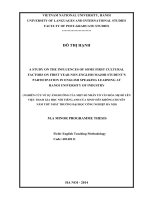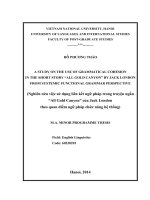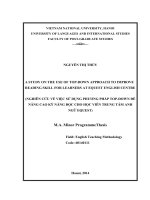study on culture conditions of high phytase production from aspergillus fumigatus size 1415
Bạn đang xem bản rút gọn của tài liệu. Xem và tải ngay bản đầy đủ của tài liệu tại đây (271.25 KB, 19 trang )
MINISTRY OF EDUCATION & TRAINING
CAN THO UNIVERSITY
BIOTECHNOLOGY RESEARCH & DEVELOPMENT INSTITUTE
SUMMARY
BACHELOR OF SCIENCE THESIS
THE ADVANCED PROGRAM IN BIOTECHNOLOGY
STUDY ON CULTURE CONDITIONS
OF HIGH PHYTASE PRODUCTION
FROM Aspergillus fumigatus
SIZE 14-15
SUPERVISOR
STUDENT
Dr. DUONG THI HUONG GIANG
NGUYEN THI NGOC DIEP
Student code: 3083916
Session: 34 (2008-2013)
Can Tho, 2013
APPROVAL
SUPERVISOR
Dr. DUONG THI HUONG GIANG
STUDENT
NGUYEN THI NGOC DIEP
Can Tho, May 15, 2013
PRESIDENT OF EXAMINATION COMMITTEE
ABSTRACT
Phytase is a group of enzymes that are able to release
phosphorus from phytate so that it can be easily digested.
Therefore, phytase is largely used in animal feed. Recently, in the
Laboratory of Enzyme Technology, Biotechonology R&D Institute,
a new isolated strain of Aspergillus fumigatus had high potential for
phytase production. In this study, the growth conditions to
improve the enzyme production of this new A. fumigatus T1 were
investigated. The strain showed maximal productivity on semisolid state medium, inoculated with one-day-old mold spores, and
supplemented with 1% phosphorus in the form of KH2PO4, 0.5%
glucose and 0.5% nitrogen in the form of malt extract. The
overall three-fold improvement of phytase activities was
achieved. The general scheme for high phytase production of A.
fumigatus was also established.
Key words: Aspergillus fumigatus T1, KH2PO4, malt
extract, one-day-old mold spore, phosphorus, phytase, phytate.
i
CONTENTS
ABSTRACT
CONTENTS
1. INTRODUCTION
2. MATERIALS AND METHODS
2.1 Materials
2.2 Methods
2.2.1 Studying the effect of the age of spore inoculum
on phytase production of A. fumigatus
2.2.2 Studying the effect of phosphorus
concentrations (KH2PO4) on phytase production of A.
fumigatus
2.2.3 Studying the effect of nitrogen sources and
concentrations on phytase production of
A.
fumigatus
2.2.4 Studying the effect of carbon sources and
concentrations on phytase production of A. fumigatus
2.2.5 Statistical analysis methods
3. RESULTS AND DISCUSSION
3.1 The effect of the age of spore inoculum on phytase
production of A. fumigatus
3.2 The effect of phosphorus concentrations (KH 2 PO4)
on phytase production of A. fumigatus
3.3 The effect of nitrogen sources and concentrations on
phytase production of A. fumigatus
3.4 The effect of carbon sources and concentrations on
phytase production of A. fumigatus
3.5 Suggested procedure for phytase production from
A. fumigatus
4. CONCLUSIONS AND SUGGESTIONS
4.1 Conclusions
4.2 Suggestions
REFERENCES
ii
i
ii
1
3
3
3
4
4
5
5
6
7
7
8
9
10
11
12
12
12
13
1. INTRODUCTION
Phosphorus is one of the elements playing an essential role
in living things since it is a structure component of nucleic acid
(DNA, RNA), phospholipid membranes, high-energy compounds
(such as ATP, NADPH) and connective tissues, etc. (Jahnke,
2000). Therefore, inorganic phosphorus as well as organic
phosphorus from plants is added into feed to support the animal
development in husbandry. However, the main storage form of
phosphorus in plants is in the form of phytate which can not be
utilized by non-ruminant animals. Additionally, phytate is
considered as an anti-nutritive factor because it is a strong
chelator of cations. It binds strongly to essential minerals such as
Ca2+, Zn2+, Mg2+, Mn2+, Fe2+/3+, and this leads to the decrease in
the mineral-absorbing ability of livestock (Singh, 2008). For
these reasons, farmers routinely add inorganic phosphorus to the
diet. The excess of inorganic phosphorus as well as phytate
excreted in the animal faeces can cause environmental
pollution.
Phytase is a group of enzymes that are able to degrade
phytate into easily digested phosphorus. In fact, using phytase can
help not only to improve the nutritional value of phytate in feed
but also to reduce the waste of inorganic phosphorus, and this
benefits the reduction of the cost for feed.
Phytase enzyme can be found in animals, plants and
microorganisms. Among them, microorganisms are the main
sources of phytase production. Especially, the most active
producers are Aspergillus genus such as A. fumigatus, A. ficuum,
1
A. oryzae and A. niger (Shimizu, 1993; Volfova et al., 1994; Liu
et al., 1999).
In comparison with phytases from other Aspergillus sp.,
phytase from Aspergillus fumigatus has a special characteristic
with high ability of refolding in heat denaturation process
(Pasamontes et al., 1997; Wyss et al., 1998), which is suitable for
implementing in feed production.
However, the research of phytase on this mold in Vietnam
is still limited. Recently, a new strain A. fumigatus T1 producing
phytase has been isolated and studied in the Enzyme Technology
Laboratory, Biotechnology R&D Institute. As the continuation of
this work, the thesis “Study on culture conditions of high phytase
production from Aspergillus fumigatus” has been performed to
have more complete figure about this strain, with the hope to
produce high phytase from this new A. fumigatus isolate.
Thesis objectives: This study aimed at studying culture
conditions of the high phytase yield from A. fumigatus.
2
2. MATERIALS AND METHODS
2.1 Materials
An A. fumigatus T 1 strain was isolated by Nguyen Van
Tinh (2012).
Media: PGA (Potato Glucose Agar), semi-solid substrate
medium (Arpana et al., 2012).
Wheat flour (organic phytase source) was purchased in
Xuan Khanh market, Ninh Kieu District, Cantho City.
Nitrogen sources: Malt extract, yeast extract, ammonium
sulfate.
Carbon sources: Glucose, fructose, maltose, sucrose.
Equipment: Eppendorf - Germany, spectrometer (Hitachi Japan), centrifuge (Rotor - Germany) and other lab facilities.
Chemicals: Sodium phytate (C6H6Na12O24P6H2O), L(+)ascorbic acid (C6H8O2) (Sigma), sodium acetate (Merck), tricloroacetic (TCA) (Merck), acetone (China), glucose, fructose,
maltose, sucrose (China), malt extract, yeast extract (Merck).
2.2 Methods
Studying culture conditions of high phytase production
from A. fumigatus isolate
Purpose: Choosing the appropriate factors such as the
inoculum mold spore age, phosphorus (KH2 PO4) concentration,
nitrogen source and nitrogen concentration, carbon source and
carbon concentration to obtain high yield of phytase from
A. fumigatus.
The semi-solid state culture medium: 45 g of wheat flour
and rice husk with the ratio of 2:1 w/w; 25 mL of mineral
solution (MgSO4.7H2O (0.1 g/L); KCl (0.5 g/L); FeSO4 (0.01
3
g/L); MnSO4 (0.01 g/L); NaCl (0.1 g/L); CaCl2 (5 g/L) and pH
5.5 (Arpana et al., 2012).
2.2.1 Studying the effect of the age of spore inoculum on
phytase production of A. fumigatus
Experimental design: Completely random with a following
factor: spore age within 7 days of cultivation.
Mold spore inoculum were used from one-day to seven-day
old. The experiment was done in triplicate with 7 treatments.
Totally, there were 21 experimental units.
Experimental performance: 7 samples of the mold spores at
different ages as mentioned above was inoculated into semi-solid
state culture medium with wheat flour as a phytate substrate,
spore density of 108 spores/mL, pH 4, incubation temperature
35°C for 2 days (Nguyen Van Tinh, 2012). The enzyme activity
was determined by the method of Heinonen and Lahti (1981).
Evaluation criteria: Phytase activity (U/g fresh biomass).
2.2.2 Studying the effect of phosphorus concentrations
(KH 2PO4) on phytase production of A. fumigatus
Experimental design: Completely random with a factor:
phosphorus in the form of KH2 PO4 with six levels of
concentration such as: 0%, 0.5%, 1%, 1.5%, 2% and 2.5%. The
experiment was done in triplicate with 6 treatments. Totally, there
were 18 experimental units.
Experimental performance: A. fumigatus was grown on the
culture medium with wheat flour (phytate substrate) at different
concentrations of phosphorus as mentioned above, spore density
of 108 spores/mL, pH 4, incubation temperature 35°C in 2 days
(Nguyen Van Tinh, 2012), the appropriate spore age was chosen
4
from 2.2.1. The enzyme activity was determined by the method
of Heinonen and Lahti (1981).
Evaluation criteria: Phytase activity (U/g fresh biomass).
2.2.3
Studying
the
effect
of
nitrogen
sources
and
concentrations on phytase production of A. fumigatus
Experimental design: Completely random with 2 factors: (i)
three nitrogen sources (malt extract, yeast extract and ammonium
sulfate) and (ii) four different levels of nitrogen concentration (0%,
0.25%, 0.5% and 0.75%). The experiment was done in triplicate
with 12 treatments. Totally, there were 36 experimental units.
Experimental performance: A. fumigatus was grown on
semi-solid state medium with wheat flour (phytate substrate) of
different nitrogen sources at different concentration levels as
mentioned above, spore density of 108 spores/mL, pH 4,
incubation temperature 35°C in 2 days (Nguyen Van Tinh, 2012),
the appropriate spore age and phosphorus concentration were
chosen from 2.2.1 and 2.2.2. The enzyme activity was
determined by the method of Heinonen and Lahti (1981).
Evaluation criteria: Phytase activity (U/g fresh biomass).
2.2.4
Studying
the
effect
of
carbon
sources
and
concentrations on phytase production of A. fumigatus
Experimental design: Completely random with 2 factors: (i)
four different carbon sources (glucose, fructose, maltose and
sucrose) and (ii) four levels of carbon concentration with 4
concentrations (0%, 0.5%, 1% and 1.5%). The experiment was
done in triplicate with 16 treatments. Totally, there were 48
experimental units.
5
Experimental performance: A. fumigatus was grown on the
culture medium with wheat flour (phytate substrate) of different
carbon sources at different concentration levels as mentioned
above, spore density about 108 spores/mL, pH 4, incubation
temperature 35°C in 2 days (Nguyen Van Tinh, 2012), the
appropriate inoculum spore age, phosphorus concentration,
nitrogen source and concentration were taken from previous
experiments. The enzyme activity was determined by the method
of Heinonen and Lahti (1981).
Evaluation criteria: Phytase activity (U/g fresh biomass).
2.2.5 Statistical analysis methods
Microsoft Exel software version 2010 and Statgraphic
software version 15.0 were used to analyze the experimental data.
6
3. RESULTS AND DISCUSSION
3.1 The effect of the age of spore inoculum on phytase
production of A. fumigatus
Inoculum spore age was known as an important factor
affecting the microbial growth as well as enzyme production of
microorganisms (Singh and Satyanarayana, 2012). In this
experiment, the A. fumigatus spores at different ages (from oneday old to seven-day old) were inoculated into the semi-solid
state culture medium with wheat flour as a phytate substrate. The
enzyme production was measured by phytase activity per gram
fresh biomass.
Figure 7. Effect of the age of spore inoculum on phytase
production of A. fumigatus
Based on the results in the Figure 7, it was found that the
productivity of the enzyme was highest (1.347 U/g) in case of
using one-day-old spore inoculum, and it was significantly
different from the other older spore ages. The spore of seven day
old gave lowest enzyme yield (0.647 U/g). It appeared that this
A. fumigatus isolate has an ability to develop in a very short time.
7
The one-day-old fungus was readily adapted to the culture
conditions to produce high level phytase for development. While
the older spores seemed to quickly enter into the dormant phase,
so they took a longer time to germinate and this lead to low
enzyme production (Singh and Satyanarayana, 2012).
Therefore, the mold spores of one-day-old was applied for
the next experiments.
3.2 The effect of phosphorus concentrations (KH2PO4) on
phytase production of A. fumigatus
It was reported that the phosphorus concentration plays an
important role in phytase production (Shieh and Ware, 1968;
Shieh et al., 1969). To determine the effect of phosphorus on
phytase production, A. fumigatus was cultivated in the growth
medium with different concentrations of KH2PO4 (Figure 8).
Figure 8. Effect of KH2PO4 concentrations on phytase
production of A. fumigatus
The enzyme activity reached a peak at the KH2PO4
concentration of 1% (1.861 U/g). Similarly, Vats and Banerjee
(2002) and Garvova and Sariyska (2003) also showed that
8
phytase synthesis was inhibited at high phosphorus content.
Therefore, KH2PO4 of 1% was used for the next
experiments.
3.3 The effect of nitrogen sources and concentrations on
phytase production of A. fumigatus
Figure 9. Effect of nitrogen sources and concentrations on
phytase production of A. fumigatus
As it was shown in the Figure 9, the nitrogen source and
nitrogen content significantly affected phytase production of
A. fumigatus. Yeast extract had the most effect at 0.25%
(3.945 U/g). However, the maximum yield of phytase was
obtained at the concentration of 0.5% (4.490 U/g), it was
remarkably higher than other malt extract concentration tested
(0.25 and 0.75%) and also higher at 0.25% yeast extract. Among
two organic nitrogen sources explored, malt extract gave much
higher phytase yield (4.490 U/g) than yeast extract (3.945 U/g),
it appeared that the plant nitrogen is a suitable source for phytase
production of A. fumigatus. Besides, the organic nitrogen sources
(malt extract and yeast extract) gave higher phytase production
9
than inorganic one (ammonium sulphate). Similarly, Sano et al.
(1999) and Vohra and Satyanarayana (2001) also reported that
organic nitrogen sources were generally better for protein
production than inorganic nitrogen sources. Furthermore, the
nitrogen supplementation >0.5% seemed to inhibit phytase
production, the phytase yield was dropped remarkably.
In sum, malt extract of 0.5% could be used for further
experiment.
3.4 The effect of carbon sources and concentrations on
phytase production of A. fumigatus
Similar to nitrogen sources, the carbon sources and carbon
content also seemed to have significant effect on the phytase
production of A. fumigatus (Figure 10).
ê
Figure 10. Effect of carbon sources and concentrations on
phytase production of A. fumigatus
Among four different sugars tested (glucose, fructose,
maltose and sucrose), the glucose of 0.5% gave highest enzyme
yield of 4.673 U/g (Figure 10). Glucose concentration >5%
10
appeared to inhibit the enzyme production (3.523 U/g at 1% and
2.984 U/g at 1.5%). A similar result was reported by Nair et al.
(1991) that phytase production of A. ficuum was also inhibited by
high glucose concentrations.
In general, 0.5% glucose was chosen for high phytase
production of A. fumigatus.
3.5
Suggested
procedure
for
phytase
production
of
A. fumigatus
Based on the above obtained results, the general scheme for
high phytase production from A. fumigatus could be established
as in Figure 11.
Figure 11. General scheme for phytase production from
A. fumigatus
11
4. CONCLUSIONS AND SUGGESTIONS
4.1 Conclusions
The optimum conditions for phytase production from
A. fumigatus T1 were determined. A. fumigatus T1 exhibited
maximum enzyme yield on the medium with wheat flour as a
phytate substrate, spore density of 108 spores/mL, incubation
temperature 35°C, pH 4 for 2 days (Nguyen Van Tinh, 2012); and
mineral supplement such as malt extract with nitrogen content of
0.5%, 1% KH2PO4, 0.5% glucose, and one-day-old spore
inoculum. The general scheme for high phytase production from
A. fumigatus was also established. An overall three-fold
improvement in the phytase production was achieved.
4.2 Suggestions
- Studying submerged incubation conditions for phytase
production since that would be easier for extraction of crude
phytase from the A. fumigatus biomass than on semi-solid culture
media.
- Studying storage conditions such as time and preservative
agents for crude phytase extract from A. fumigatus to apply
efficiently in animal feed.
- Purification and characterization of the phytase enzyme
from this A. fumigatus isolate.
- Studying application of this phytase enzyme product in
aquaculture and husbandry.
12
REFERENCES
Vietnamese
Nguyễn Văn Tính. 2012. Phân lập và khảo sát môi trường nuôi
cấy nấm Aspergillus fumigatus sinh tổng hợp phytase cao.
Luận văn tốt nghiệp Đại học chuyên ngành Công nghệ Sinh
học. Đại học Cần Thơ.
English
Arpana, M., S. Gulab, G. Varsha, Y. Anita and N.K. Aggarwal.
2012. Production of phytase by acido-thermophilic strain of
Klebsiella sp. DB-3 FJ711774.1 using orange peel flour
under submerged fermentation. Inno Romanian Food
Biotechnol, 10:18-27.
Gargova, S. and M. Sariyska. 2003. Effect of culture conditions
on the biosynthesis of Aspergillus niger phytase and acid
phosphatase. Enzyme Microbial Technol, 32(2):231-235.
Heinonen, J.K. and R.J. Lahti. 1981. A new and convenient
colorimetric determination of inorganic orthophosphate and
its application to the assay of inorganic pyrophosphatase.
Anal Biochem, 113(2):313-317.
Jahnke, R.A. 2000. The Phosphorus Cycle. In Earth System
Science, ed. R.C.M. Jacobson: Academic Press, pp.360376.
Liu, B.L., C.H. Jong and Y.M. Tzeng. 1999. Effect of
immobilization on pH and thermal stability of Aspergillus
ficuum phytase. Enzyme Microbial Technol, 25(6):517-521.
Nair, V.C., J. Laflamme and Z. Duvnjak. 1991. Production of
phytase by Aspergillus ficuum and reduction of phytic acid
13
content in canola meal. J Sci Food and Agri, 54(3):355365.
Pasamontes, L., M. Haiker, M. Wyss, M. Tessier and A.P. van
Loon.
1997.
Gene
cloning,
purification,
and
characterization of a heat-stable phytase from the fungus
Aspergillus
fumigatus.
Appl
Environ
Microbiol,
63(5):1696-1700.
Sano, K., H. Fukuhara and Y. Nakamura. 1999. Phytase of the
yeast Arxula adeninivorans. Biotechnol Letters, 21(1):3338.
Shieh, T.R. and J.H. Ware. 1968. Survey of Microorganisms for
the Production of Extracellular Phytase. Appl Microbiol,
16(9):1348-1351.
Shieh, T.R., R.J. Wodzinski and J.H. Ware. 1969. Regulation of
the formation of acid phosphatases by inorganic phosphate
in Aspergillus ficuum. J Bacteriol, 100(3):1161-1165.
Shimizu, M. 1993. Purification and Characterization of Phytase
and Acid Phosphatase Produced by Aspergillus oryzae K1.
Biosci Biotechnol Biochem, 57(8):1364-1365.
Singh, B. and T. Satyanarayana. 2012. Production of phytatehydrolyzing enzymes by thermophilic moulds. African J
Biotechnol, 11(59):12314-12324.
Singh, P.K. 2008. Significance of phytic acid and supplemental
phytase in chicken nutrition: a review. World's Poultry Sci
J, 64(04):553-580.
Vats, P. and U.C. Banerjee. 2002. Studies on the production of
phytase by a newly isolated strain of Aspergillus niger var
14
teigham obtained from rotten wood-logs. Pro Biochem,
38(2):211-217.
Vohra, A. and T. Satyanarayana. 2001. Phytase production by the
yeast, Pichia anomala. Biotechnol Letters, 23(7):551-554.
Volfova, O., J. Dvorakova, A. Hanzlikova and A. Jandera. 1994.
Phytase from Aspergillus niger. Folia Microbiol (Praha),
39(6):481-484.
Wyss, M., L. Pasamontes, R. Remy, J. Kohler, E. Kusznir, M.
Gadient, F. Muller and A. van Loon. 1998. Comparison of
the thermostability properties of three acid phosphatases
from molds: Aspergillus fumigatus phytase, A. niger
phytase, and A. niger PH 2.5 acid phosphatase. Appl
Environ Microbiol, 64(11):4446-4451.
15









